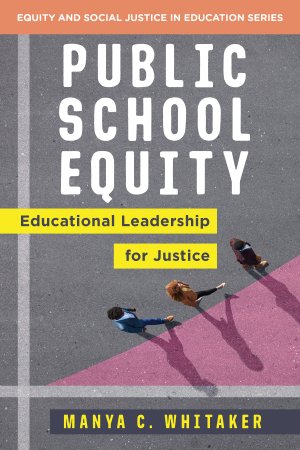Equity in Schools Begins With Changing Mindsets
A new book explores how school leaders can foster equity by building a culture where teachers and students see their purpose and experience success.
Your content has been saved!
Go to My Saved Content.The single variable that best predicts students’ sense of belonging is their relationship with teachers. This is more important than their race, socioeconomic status, academic achievement, and their relationships with peers. Strong teacher-student relationships can mitigate the cumulative effects of misbehavior, apathy, and failure due to poor teacher-student relationships. By improving students’ motivation, engagement, academic self-regulation, and overall achievement, teacher-student relationships offer schools continual opportunities to support students’ learning.

Such support is both interpersonal and instructional. Qualitative interviews reveal students’ preferences for teachers who respect them (i.e., don’t yell, pronounce their names properly), trust them, and don’t police minor behaviors (e.g., head on desk, sitting sideways in a chair). They like it when teachers initiate help so that they don’t have to ask questions and risk embarrassment in front of peers. When they perform well, they expect positive feedback. When they are not doing well, they appreciate teachers who communicate about their progress and offer opportunities to improve.
Teachers who fail to connect with students interpersonally or instructionally may be disengaged from their teacher role. While teachers report leaving schools because of a lack of administrative leadership, they also report job dissatisfaction because of students. Student tardiness, student absenteeism, class cutting, student dropouts, poor student health, and student apathy contribute to teachers’ lack of professional enthusiasm. These factors are compounded by teachers’ complaints about high poverty and low family involvement. Because of the correlation between race and income in the United States, these variables are present in most schools serving minoritized youth where cultural mismatch between teachers and students further complicates the development of strong teacher-student bonds (discussed in Chapter 5). This is not to say that students from underserved communities will never experience a strong sense of belonging. On the contrary, students whose schools are committed to inclusion will naturally feel welcomed and appreciated.
Framing Equity
Cultivating a school climate for equity requires careful attention to the creation of emotional, cognitive, and behavioral spaces throughout the school. It is useful to think of the climate through three lenses (L.S. Shulman, “Signature Pedagogies in the Professions,” 2005):
- Habits of heart—core values; why do you teach?
- Habits of head—ways of thinking and knowing; what do you believe?
- Habits of hand—what you do; how do you practice your values and beliefs?
These habits will be enacted differently through interactions with students versus staff, but for each, the goal is to foster their motivation to perform to the best of their abilities by creating an environment where they want to be, where they see the purpose in being, and where they experience success. An expectancy-value theory of motivation (J. Eccles et al., “Expectancies, Values, and Academic Behaviors,” 1983) offers four suggestions for increasing intrinsic motivation:
1. Create a space where people enjoy themselves and can do things that interest them. For students, this means a variety of course options, multiple extracurricular activities, and innovative, hands-on learning experiences. For teachers this may mean variety in teaching assignments, autonomous decision-making, and opportunities to develop new classes.
2. Keep your revised equity-focused vision and mission at the core of school functioning. Clearly and consistently communicate your vision and explain how every decision contributes to the realization of the vision. The key here is transparency and honesty when explaining the utility of a particular assignment or class to students, and a new policy to staff.
3. Affirm everyone’s contribution to the school community. This could be asking students to facilitate lessons or be peer mentors. You might invite staff to lead an initiative or promote them into a new position.
4. Minimize emotional costs by making sure that role expectations are reasonable (i.e., that the outcome will be worth the effort), that they leave time for other enjoyable tasks, and that they do not engender negative emotions. Students and staff should not be given busywork, be overworked, or be asked to do things which they are not capable of doing.
Each of these contributes to a positive school climate because it recognizes and leverages individuality, acknowledges accomplishments, and encourages continual engagement in the school community. School leaders can mistakenly put the climate on autopilot thinking that it will run on its own once people understand their role and are given their scripts. But a school climate is dynamic, open to influence from a variety of sources, so it must be consistently monitored and adjusted. Most importantly, because it is largely people who both shape and are shaped by the school climate, they too must be nurtured.
School Policies
Conversations about educational equity begin with policies because they determine what is and what is not allowed in schools. Many educators, students, and families interpret policies as if they are laws when, in fact, they are not. Policies are guidelines used to achieve specific goals. They are locally determined and implemented at the discretion of relevant decision-makers. In the United States, education is overseen by individual states that pass most decision-making to local educational agencies (LEAs) or school districts. Most education policies originate from school districts overseen by a school board composed of 4–10 elected or appointed volunteers. School leaders have flexibility about when and how to implement district policies.
The problem with policies is that they are written as one-size-fits-all guidelines, which, while equal, is not equitable. Inequities are exacerbated by school staff’s inconsistent application of policies such that implicit biases and explicit prejudices mean some students are disproportionately subject to school policies whereas others are not. The most frequently cited policy that is inequitably enforced is zero tolerance school discipline policies. Though initially proposed at the national level in response to school shootings, since its inception in 1994, zero tolerance has expanded beyond weapons to minor infractions such as dress-code violations and subjective offenses like disrupting class, offensive language, and disrespectful behavior. In schools designed according to White sociocultural norms, it is BISOC—Black, Indigenous, and students of color—who experience disproportionate rates of detention, suspension, and expulsion.
Consequently, racially minoritized students, especially Black and Latinx students, miss critical learning opportunities. The Civil Rights Project (2020) found that in one academic year, U.S. students lost 11 million days of instruction due to suspensions. When suspension data is disaggregated by race and gender, Black boys lost 132 days per 100 students enrolled and Black girls lost 77 days per 100 students, 7 times higher than White girls.
It is important to emphasize that discipline policies themselves are not automatically inequitable. The biased implementation of them is what creates discipline gaps that sustain opportunity gaps. This is true of most education policies, especially academic ones. For instance, tracking and sorting dictate students’ opportunities to learn (OTLs) by placing them on an educational path that restricts the courses in which they can enroll in the future. The existence of academic courses with varying levels of rigor is not in itself problematic. The issue lies in how students are placed into certain courses.
It is common for individual teachers to use their discretion to decide which students can succeed in which tracks and make recommendations for placements. Teachers’ perceptions are informed by their observations and interpretations of students’ behavior, and their assessment of their academic work compared to other students. Academic sorting methods are exceedingly subjective and worrisome. As with discipline policies, teachers’ biases against BISOC, students with disabilities, and boys means that White and Asian girls are those most often enrolled in gifted programs. Even when school policies require academic testing for course placement, students can be incorrectly sorted because standardized tests are culturally biased, lack predictive validity, and do not account for children’s cognitive variability.
This is especially true for English language learners (ELLs), who, after being assessed in English, are frequently sorted into academic tracks that do not reflect their true capabilities. Some multilingual students are mainstreamed into courses with English-speaking students and are pulled out for intensive English instruction. Others experience full English immersion and receive no English instruction. In both cases, students are given far fewer OTLs because they are not receiving instruction in their heritage language and, in the case of pull-out programs, are missing content area instruction while receiving English language instruction.
Academic policies should enhance educational opportunities, not limit them. Whether students experience reduced OTLs because their school simply does not offer certain courses, they are prevented from enrolling in courses, or because they are absent from class, has long-term implications for their educational achievement. For example, certain courses (e.g., Algebra 1, Biology, Chemistry 1) function as prerequisites for future courses, so without the opportunity to enroll in early courses, students will never be able to advance in that subject area. Even for the same course, content variation can greatly differ across academic tracks, resulting in unequal preparation for future learning.
The cumulative nature of learning means that students’ early school experiences can and do predict future OTLs, but they do not predict students’ future abilities. It is never too late to disrupt the cycle of educational inequity by expanding students’ OTLs through equitable school policies.
Excerpted from Public School Equity: Educational Leadership for Justice, © 2022 by Manya Whitaker. Used with permission of the publisher, W. W. Norton & Company, Inc.
Editor’s note: Edutopia readers will receive a discount when using the link above in 2022.
